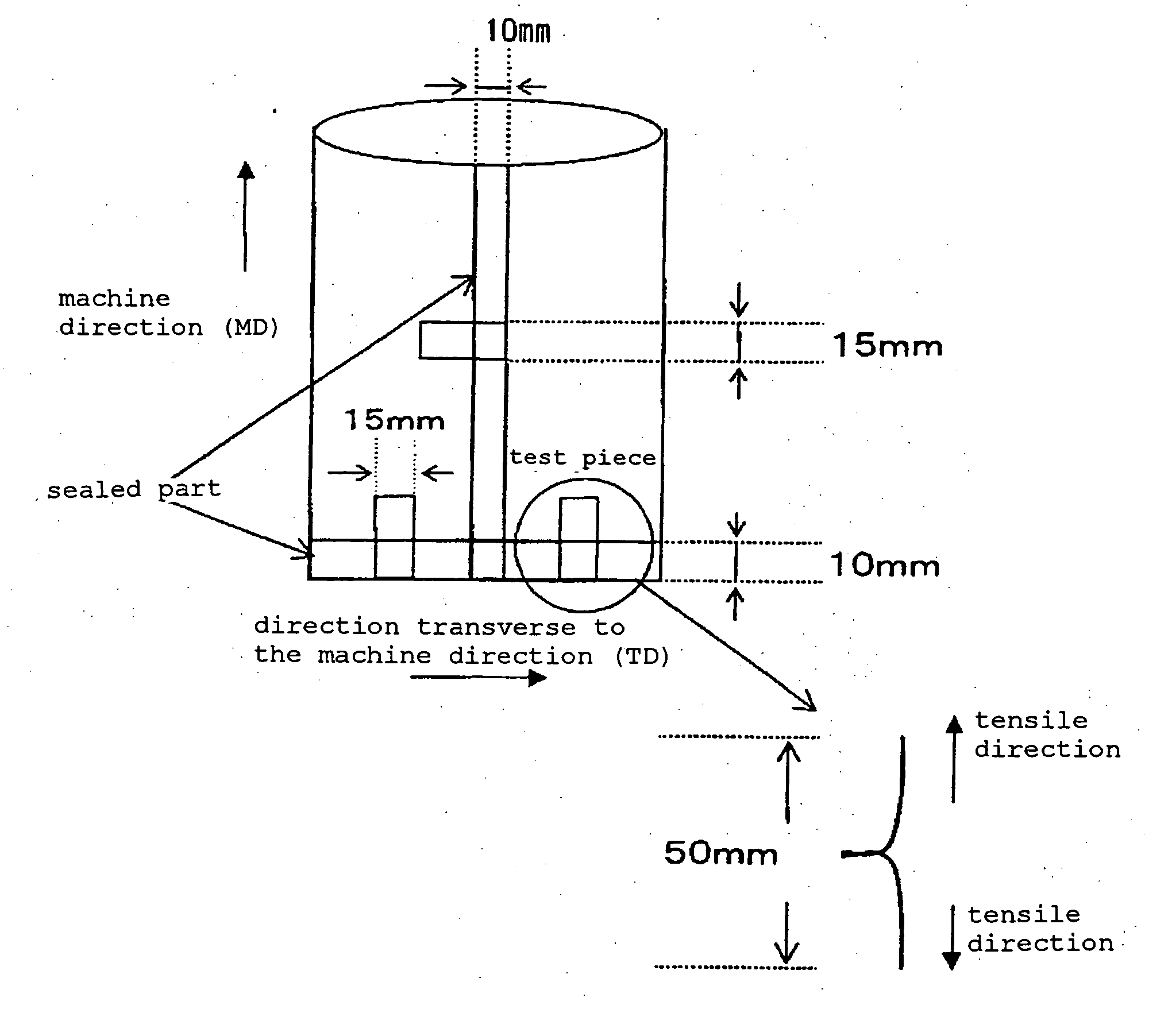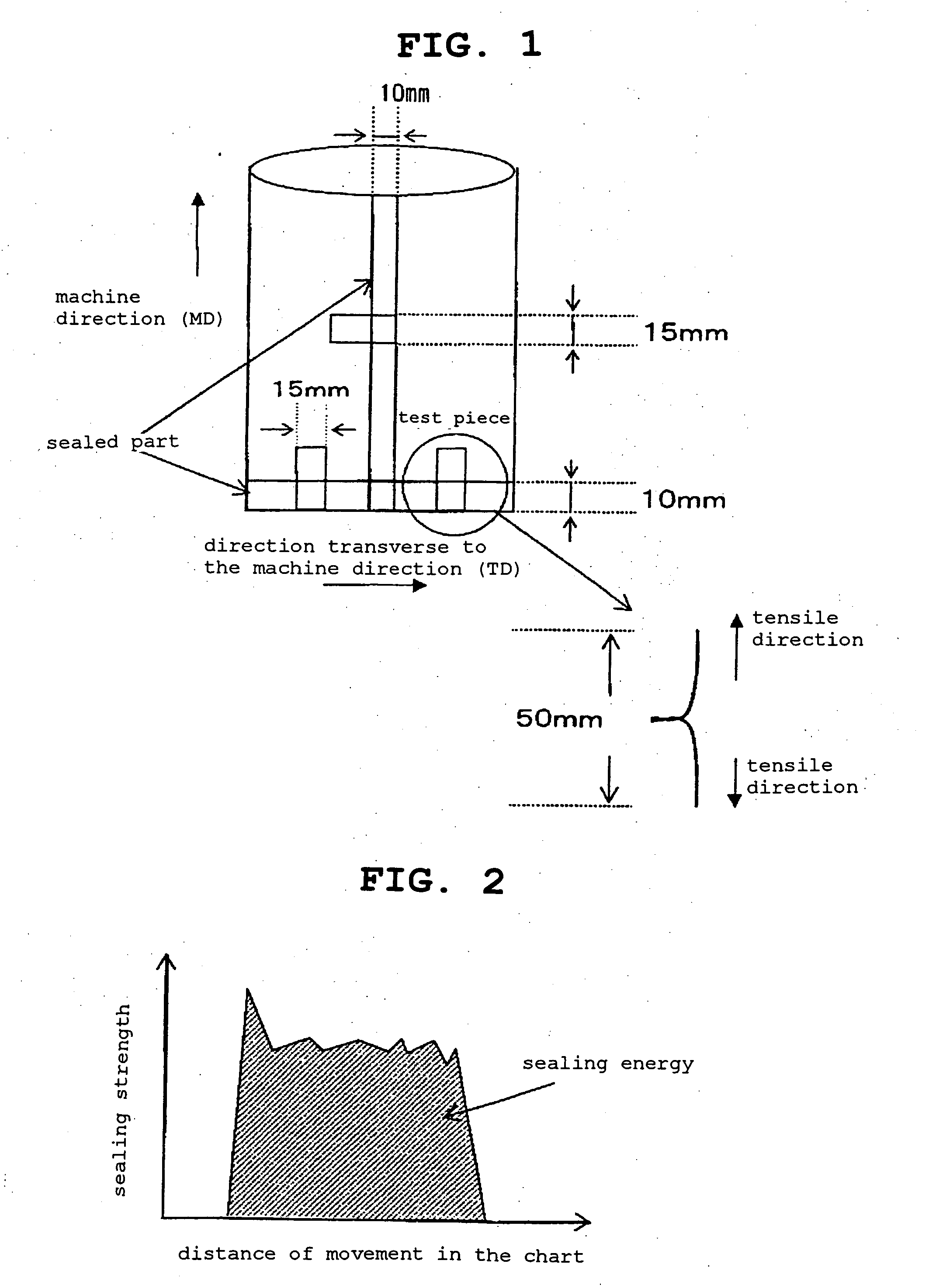Heat-Sealable Layered Polypropylene Resin Film and Package
a polypropylene resin and layered technology, applied in the field of heat sealing films, can solve the problems of polyethylene resin impairing film toughness, weak adhesion strength between layers, and difficult to achieve heat sealing strength sufficient for packaging heavy goods, etc., to achieve high heat sealing energy, good toughness, and high heat sealing strength
- Summary
- Abstract
- Description
- Claims
- Application Information
AI Technical Summary
Benefits of technology
Problems solved by technology
Method used
Image
Examples
production example 1
[0103] Using three melt extruders, substrate layer A (propylene homopolymer) was melt-extruded from the first extruder, heat sealable layer C (resin mixture of propylene•ethylene•butene random copolymer-1: 10 parts by mass, propylene˜butene copolymer-1: 90 parts by mass) was melt-extruded from the second extruder, and intermediate layer B (resin mixture of propylene·ethylene·butene random copolymer-1: 40% by mass, propylene homopolymer: 60% by mass) was melt-extruded from the third extruder, each at a resin temperature of 260° C., and laminated in a T die to form substrate layer A / intermediate layer B / heat sealable layer C, which was cool-solidified on a chill roll at 20° C. Then, the obtained unoriented film was stretched 4.5-fold in the longitudinal direction, and 8-fold in the transverse direction to give a packaging laminate film 1 (40 μm) having substrate layer A: 10 μm, intermediate layer B: 28 μm, and heat sealable layer C: 2 μm. The constitution and evaluation results of lam...
production example 2
[0105] Using three melt extruders, substrate layer A (resin mixture of propylene homopolymer: 100 parts by mass, polyoxyethylene(2)stearylaminemonostearic acid ester: 0.8 part by mass, polyoxyethylene(2)stearylamine: 0.2 part by mass, stearic acid monoglycerolester: 0.2 part by mass) was melt-extruded from the first extruder, heat sealable layer C (resin mixture of propylene•ethylene•butene copolymer-1: 10 parts by mass and propylene•butene copolymer-1: 90 parts by mass) was melt-extruded from the second extruder, and intermediate layer B (resin mixture of a resin mixture of propylene•ethylene•butene random copolymer-1: 40% by mass and propylene homopolymer: 60% by mass, and polyoxyethylene(2)stearylaminemonostearic acid ester: 0.3 part by weight, polyoxyethylene(2)stearylamine: 0.1 part by weight and stearic acid monoglycerolester: 0.24 part by weight) was melt-extruded from the third extruder, each at a resin temperature of 260° C., and laminated in a T die to form substrate layer...
production example 3
[0108] In the same manner as in Production Example 2 except that the level of corona treatment was adjusted to achieve the wetting tension (after water washing) of the surface of the heat sealable layer C as shown in Table 1, laminate films 3 and 4 were obtained. The constitution and evaluation results of the laminate films are shown in Table 1.
[0109] The laminate films 3 and 4 were superior in heat sealing strength, heat sealing energy and toughness. Since the corona discharge treatment of the laminate film 4 was insufficient, the antifog property was somewhat low.
PUM
| Property | Measurement | Unit |
|---|---|---|
| melting point | aaaaa | aaaaa |
| heat sealing strength | aaaaa | aaaaa |
| wetting tension | aaaaa | aaaaa |
Abstract
Description
Claims
Application Information
 Login to View More
Login to View More - R&D
- Intellectual Property
- Life Sciences
- Materials
- Tech Scout
- Unparalleled Data Quality
- Higher Quality Content
- 60% Fewer Hallucinations
Browse by: Latest US Patents, China's latest patents, Technical Efficacy Thesaurus, Application Domain, Technology Topic, Popular Technical Reports.
© 2025 PatSnap. All rights reserved.Legal|Privacy policy|Modern Slavery Act Transparency Statement|Sitemap|About US| Contact US: help@patsnap.com


